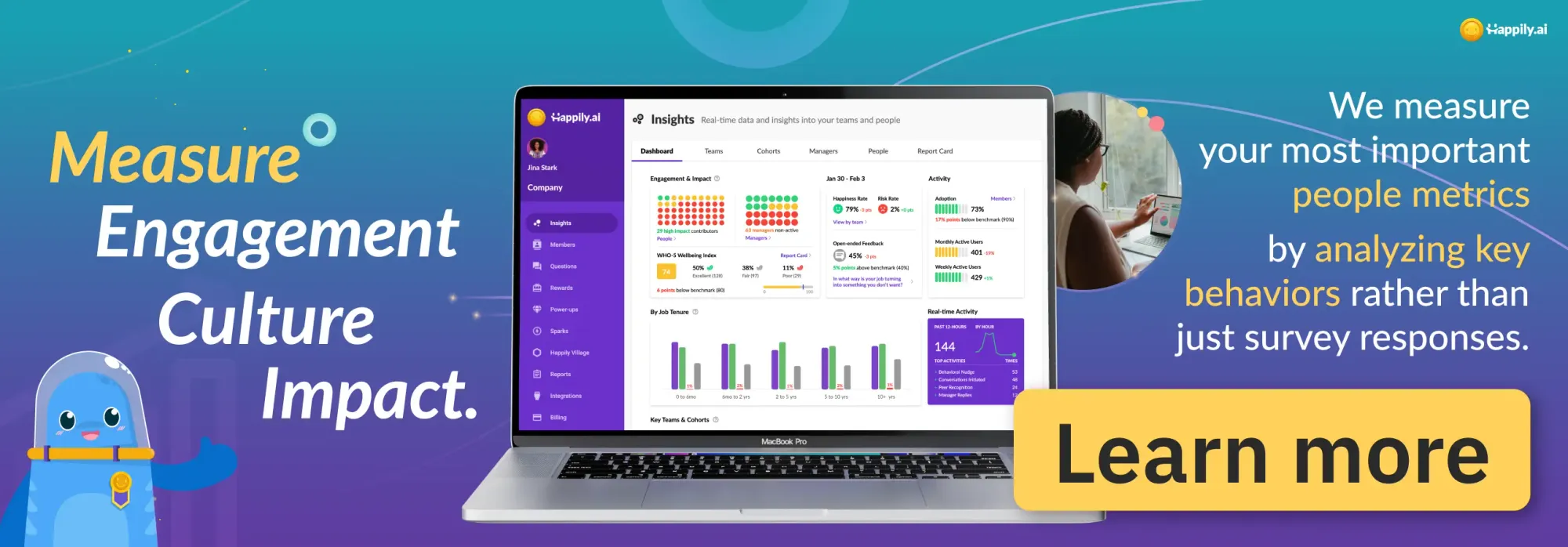Employee engagement is crucial for the success of any organization. Engaged employees are more productive, have higher job satisfaction, and are more likely to stay with the company for longer periods. Measuring employee engagement is essential for organizations to understand their employees' level of engagement and take the necessary steps to improve it. This blog post will discuss the key metrics and tools for assessing employee engagement.
Key Metrics for Measuring Employee Engagement
- Employee Net Promoter Score (eNPS): The eNPS measures the likelihood of an employee recommending the organization to others. The score is calculated by subtracting the percentage of employees who are detractors (score 0-6) from those who are promoters (score 9-10). A high eNPS indicates that employees are highly engaged and satisfied with their work.
- Employee Satisfaction Score (ESS): The ESS measures the level of employee satisfaction with their job and work environment. It can be measured through surveys or interviews, and the score can be used to identify areas where the organization needs to improve to increase employee satisfaction.
- Employee Turnover Rate: The employee turnover rate measures the number of employees who leave the organization over a specific period. A high turnover rate indicates that employees are not engaged and satisfied with their work, and the organization needs to take steps to improve employee engagement.
- Employee Retention Rate: Employee retention measures how many employees stay with the organization over time. High employee retention indicates employee engagement, as engaged employees are more likely to stay with the company. This metric is helpful alongside the turnover rate as it provides a more comprehensive understanding of employee movement.
- Employee Well-Being: Employee well-being measures how employees feel about their physical and mental health, work-life balance, and overall quality of life. High levels of well-being are associated with high levels of employee engagement. Organizations can measure employee well-being through surveys or health assessments.
- Culture & Core Values: Culture and core values measure how well an organization's culture aligns with its stated values. Employees who feel that their organization's culture aligns with its core values are more likely to be engaged. Organizations can measure culture and core values through surveys or focus groups.
Research has shown that these metrics are also strongly correlated with employee engagement. For example, a study by the World Economic Forum found that companies with a solid commitment to employee well-being had higher levels of employee engagement and productivity. Similarly, a study by the Harvard Business Review found that organizations with strong cultures had lower employee turnover rates and higher levels of job satisfaction.
Tools for Assessing Employee Engagement
- Pulse Surveys: Pulse surveys are short, frequent surveys that ask employees about their job satisfaction, work environment, and engagement level. These surveys are useful in identifying changes in employee engagement and satisfaction over time.
- Employee Feedback Platforms: Employee feedback platforms, such as Happily.ai, 15Five and Officevibe, provide a platform for employees to provide feedback and suggestions to the organization. These platforms are useful in identifying areas where the organization can improve to increase employee engagement.
- Performance Reviews: Performance reviews allow managers and employees to discuss job performance, career goals, and areas for improvement. These discussions can also include feedback on employee engagement and satisfaction, providing an opportunity for the organization to identify areas where improvements can be made.
- Employee Engagement Surveys: Employee engagement surveys are comprehensive surveys that measure the level of employee engagement, satisfaction, and loyalty within the organization. These surveys can cover various aspects such as job satisfaction, leadership, communication, work-life balance, and more. The results of these surveys can provide a holistic view of employee engagement and help organizations identify the root causes of disengagement and implement targeted interventions.

The Business Case for Employee Engagement
Employee engagement is not just a feel-good metric; it directly impacts business outcomes. Engaged employees are more likely to go above and beyond their job responsibilities, resulting in increased productivity, higher quality work, and improved customer satisfaction. They are also more likely to stay with the organization for longer periods, reducing turnover costs and increasing institutional knowledge. Furthermore, engaged employees are more innovative and collaborative, leading to better teamwork and problem-solving. On the other hand, disengaged employees can significantly negatively impact the organization, leading to lower productivity, increased absenteeism, and higher turnover rates. Therefore, measuring and improving employee engagement is critical for the success of any organization.
Measuring employee engagement is essential for organizations to understand their employees' level of engagement and take the necessary steps to improve it. Key metrics such as eNPS, ESS, employee turnover rate, employee retention rate, employee well-being, culture & core values, and tools such as pulse surveys, employee feedback platforms, and performance reviews can provide valuable insights into employee engagement. Organizations can increase productivity, reduce turnover, and improve overall job satisfaction by measuring and improving employee engagement. Invest in improving employee engagement and see the positive impact on your organization's success. Start measuring and improving employee engagement today!










